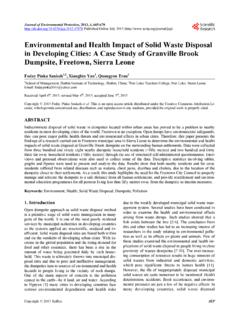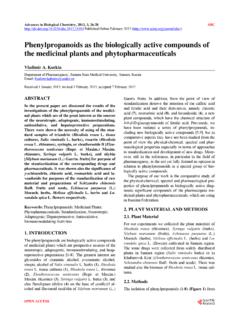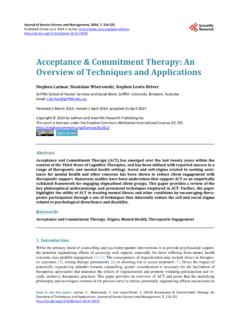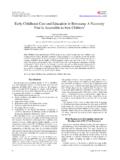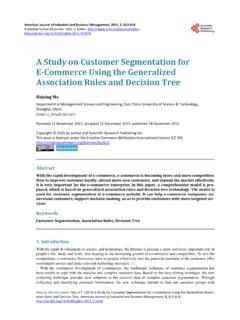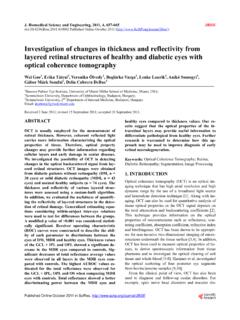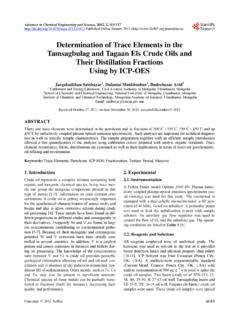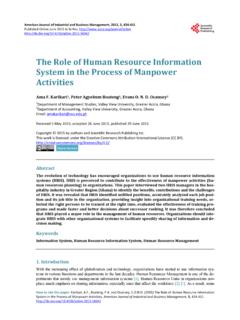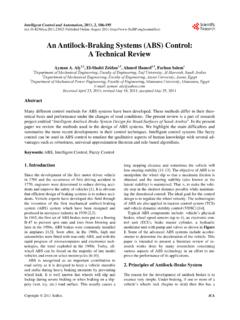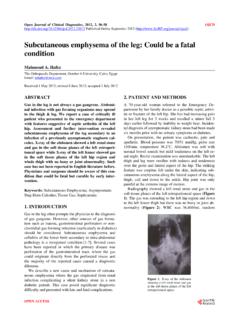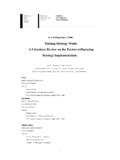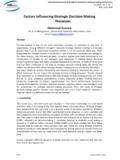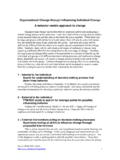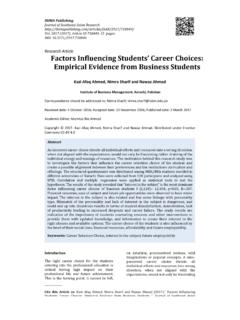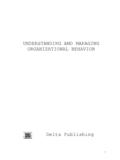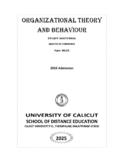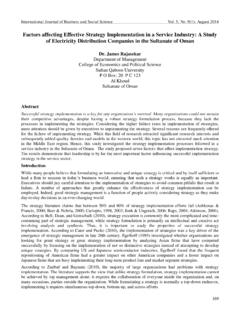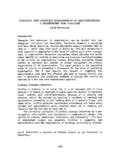Transcription of Organizational Structure: Influencing Factors and …
1 American Journal of Industrial and Business Management, 2013, 3, 229-236 Published Online April 2013 ( ) 229 Organizational structure : Influencing Factors and Impact on a Firm Quangyen Tran1,2, Yezhuang Tian1 1 School of Management, Harbin Institute of Technology, Harbin, China; 2 National Economics University, Hanoi, Vietnam. Email: Received November 3rd, 2012; revised December 17th, 2012; accepted January 18th, 2013 Copyright 2013 Quangyen Tran, Yezhuang Tian. This is an open access article distributed under the Creative Commons Attri- bution License, which permits unrestricted use, distribution, and reproduction in any medium, provided the original work is properly cited. ABSTRACT The influence of certain Factors on Organizational structure has been in researchers focus for years, together with their impact on the overall Organizational efficiency. Many of these Factors are from the environment where traditional view commonly divided into internal and external Factors .
2 This paper presents the findings of a study to evaluate the influ- encing Factors and impact on Organizational structure of a sample of firms located in Hanoi, Vietnam. Structured ques- tionnaires were administered with respect to these Factors . The variables studied were identified from among the Factors considered in contingency theory and by incorporating elements of the strategic choice approach. After grouping the variables into two Factors (related to external and internal respectively), the results revealed three groups of firms ac- cording to how they regarded the impact of these Factors on Organizational structures. In those groups that consider the variables of internal Factors to be modifiers of structure the Organizational structures are of the complex classical type, whereas simple forms predominate in the group that believes these variables do not modify their structure . Keywords: Organizational structure ; Firm; Influencing Factors ; Contingency; Resources 1.
3 Introduction Organizations are formed by groups of people with the purpose of achieving effects that one person cannot achieve individually. Better results are created as a con- sequence of Organizational effect which directs organiza- tion to achieving some Organizational goals [1]. Regard- ing the purpose of the organization s founding, they can be described as successful (profitable) or failure (non- profitable) ones. To achieve these goals organizations create inner order and relations among Organizational parts that can be described as Organizational structure . All Organizational parts together with relations and me- chanisms of their coordination are important for proper functioning of any organization. Organizations are influ- enced by many Factors which come from their dynamic surrounding or from the organization itself. Due to the static nature of Organizational structure , it sometimes can- not meet requirements of efficiency and adoptability.
4 Classics in the field of organization theory represented many different schools of Influencing Factors on organ- izational structure . Some believed that certain Factors , such as size, environment, or technology, determined Organizational structure . They argued that these Factors imposed economic or other constrains on organizations that forced them to choose a certain structure over others. Organizational structure is partly affected by the firm s external environment [2-5]. Research suggested that firms organized to deal with reliable and stable market may not be as effective in a complex, rapidly changing environment [6,7]. The more certain the environment is, the more centralized hierarchy the firm s Organizational structure may have, with formalized rules and proce- dures [5]. Organizations that operate with a high degree of environmental uncertainty may decentralize decision- making [8], relying on formal rules and policies [9], and flatten their hierarchies [10].
5 The influence of certain Factors on Organizational structure is traditionally divided into two main Factors . These Factors which determine the structure , aims and activities of the organization, can be grouped into external Factors and internal Factors [11]. External Factors are those Factors from the enabling en- vironment which are not under the control of the organi- zation but which affect its structure and development. These include economic Factors which define the eco- nomic situation where production and processing take Copyright 2013 SciRes. AJIBM Organizational structure : Influencing Factors and Impact on a Firm 230 place (the market/industry); socio-economic Factors that define the socio-economic context in which the organiza- tion operates; and political-administrative Factors which define the legal boundaries and Organizational options.
6 Internal Factors are those Organizational characteristics which create a basis for measuring and comparing or- ganizations. These include mission statement of the or- ganization and Organizational instruments. 2. Literature Review The Concept of Organizational structure There are many different opinions and definitions on Organizational structure . structure in one sense is the arrangement of duties use for the work to be done. This is best represented by the organization chart [12]. In an- other sense, structure is the architecture of business competence, leadership, talent, functional relationships and arrangement [13]. Walton [14] identified structure as the basis for organizing, to include hierarchical levels and spans of responsibility, roles and positions, and mechanisms for integration and problem solving. Thomp- son [15] said that structure is the internal differentiation and patterning of relationships.
7 He referred to structure as the means by which the organization sets limits and boundaries for efficient performance by its members, by delimiting responsibilities, control over resources, and other matters. Kartz and Kahn [16] said that structure is found in an interrelated set of events which return to complete and renew a cycle of activities. Jackson and Morgan [12] used a modified definition originally for-mulated by [17]. They defined structure as the relatively enduring allocation of work roles and administrative mechanisms that creates a pattern of interrelated work activities and allows the organization to conduct, coordi-nate, and control its activities . Lawrence and Lorsch [5] describe structure as the technique in which the organi- zation is differentiated and integrated . Differentiation is related to the scope in which executives act quasi entre- preneurs, whereas integration is described in such a way that every member of the organization including manag- ers will do their best to achieve Organizational goals.
8 Similarly, an organization is a set of elements in interac- tion, organized level and decision making units [18]. Identification of these elements has always been one of the most important issues facing Organizational research- ers. According to Dictionary- Organizational behavioral [19], Organizational structure is defined as the estab- lished pattern of relationships among the components of parts of company (The way a company is set-up). They formally defined framework of an organization s task and authority relationships . Sablynski [20] succinctly defined Organizational structure as how job tasks are formally divided, grouped, and coordinated . Or- ganiza-tion structure indicates an enduring configuration of tasks and activities [21]. In other words, organiza- tional structure is a set of methods through which, the organiza-tion divided into distinct tasks and then create a harmony between different duties [22].
9 Underdown [23] said or-ganizational structure is the formal system of task and reporting relationships that controls, coordinates, and motivates employees so that they cooperate to achieve an organization s goals . Andrews [24] stated that organiza- tional structure consists of job positions, their relation- ships to each other and accountabilities for the process and sub-process deliverables . Organizational structure directs the competence of work, the enthusiasm of em- ployees and coordination among the top management and subordinates for flow of plans and goals in the organiza- tion to sketch the future plans [25]. Organizational struc- ture is a way responsibility and power are allocated, and work procedures are carried out, among Organizational members [8,10,26-29]. Zheng, et al., [30] mentioned that the most important components of Organizational struc- ture include formalization, centralization, and control.
10 Formalization measures the extent to which an organiza- tion uses rules and procedures to prescribe behaviour [31]. The nature of formalization is the degree to which the workers are provided with rules and procedures [32] that deprive versus encourage creative, autonomous work and learning. In organization with high formalization, there are explicit rules which are likely to impede the spontaneity and flexibility needed for internal innovation [33]. Centralization refers to the hierarchical level that has authority to make decision. If decisions are delegated to lower levels the organization is decentralized and if deci- sion making power authority is kept at the top level it is centralized [34]. Centralization also creates a non-par- ticipatory environment that reduces communication, com- mitment, and involvement with tasks among partici- pants [33].
